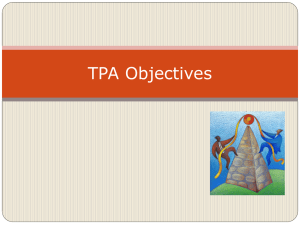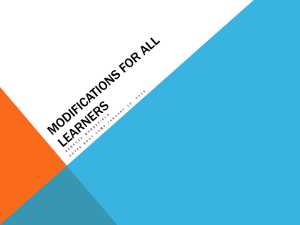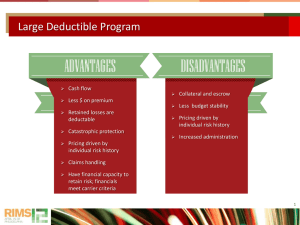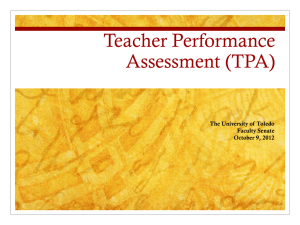Latest Trends in the 403(b)
advertisement
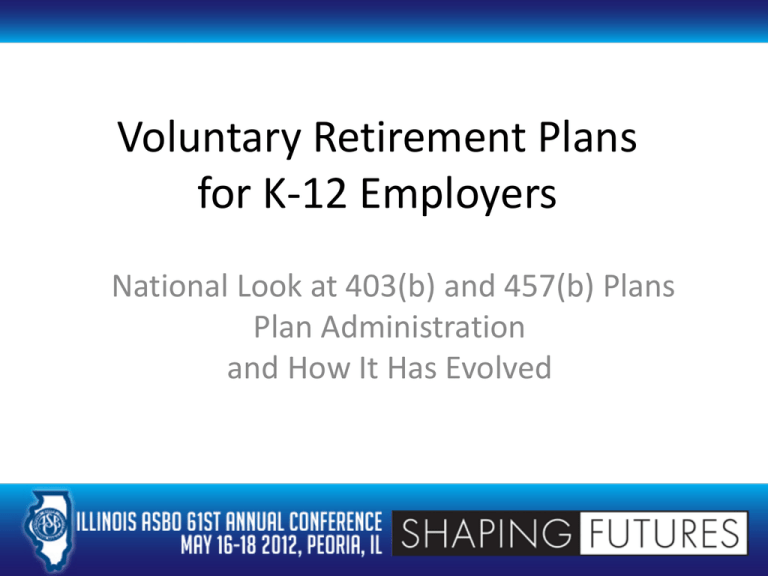
Voluntary Retirement Plans for K-12 Employers National Look at 403(b) and 457(b) Plans Plan Administration and How It Has Evolved Overview • The 403(b)and 457(b) marketplace with third party administrators (“TPAs”) - Do you really need a TPA? • Understanding what a TPA is • How they are affecting the national marketplace • Fees and how they affect your plan(s) • A look to the future 403(b) and 457(b) Marketplace • • • • Multiple Investment Providers Single Investment Providers State Run 403(b) Switching to 457(b) Plans Why Use a TPA? • Coordination of Data Sharing “You Want to Play the Game, You’d Better Know the Rules” • What is a TPA? – Third party administrator – provides some level of support benefit plan administration and/or transaction processing – What does a TPA do? • It depends – On what the agreement says… – No universal standard – Do It Yourself to full service available » Checklists » Providers of various services provided (next slide) » Sometimes unnecessary services are provided Kinds of “TPAs” in Marketplace • Common remitters – payroll processing and contribution reconciling • Data Aggregators – track participant account information and transactions that occur in accounts – May also track contributions by source (but not always) • Fee for Service – provides some services necessary for plan support as selected by employer or as limited by TPA • Full service TPA – can provide all services necessary for day to day administration, participant education and plan compliance – Employer may elect not to utilize all available services • And variations on those themes… Why Does the Kind of TPA Matter? • Two main reasons – Risk and Cost • The employer is responsible for the 403(b)/457(b) plan and everything that happens under the plans • Whatever the TPA does not do must be done by another (the employer has ultimate responsibility) • The employer is still responsible for what the TPA does on behalf of the employer – A good contract can provide financial protections, but cannot shift liabilities away from the plan sponsor TPA Role • TPA represents the employer as compliance partner • What kind of partner do you want or need? • • • • • Full service partners Quasi-partners Data storage/managers Common remitting services Contract services • YOU should know what role the TPA has – Relationship will define what services the employer has “elected” to perform Fees • Depending on level of support TPA is providing, cost will be factor for payer • This has complicated the marketplace as reasonableness of fees depends on level of services provided • 2010 & 2011 Compliance Summit in Chicago and Dallas – ASBO was represented – Report available the NTSAA and ASBO International – Impact (next slide) TPA Fees and Impact on Marketplace • Issue: Reasonableness of fees – Depends on services provided • Employers do not understand different levels of service – Full service, data aggregators, contract providers, etc – Independent or affiliated • Basis for applying the fees – – – – Per participant Per eligible employee Per transaction Free Who Pays? • Who is paying the administration fees? – Great regional variances • In some areas employers are paying all TPA fees – – – – Larger districts More RFP based May be required by state statute Recommended by consultant » For quality control » As part of total benefits package Nationwide Review • Strong Collective Bargaining Groups? – More involved in vendor issues than TPA issues – More and more vendors pay all or some portion of TPA fees – More difficult to pass on to employees • Smaller districts – Vendors pay fees – In some cases employers are paying fees – Or some portion of fees • Trend is toward employer paying fees – May charge vendors some fees to offset expense • NOT “pay to play,” but plan participation fee Failure to Understand Basis for Determining Fees • How fees are assessed – Flat fee, per head or “basis points” – Based on: • • • • Eligible employees Contributing participants Participants with active account balances Transactions – Some combination of the above • Any TPA engagement should provide transparency of fee determination and specific services provided What Will the TPA Do for These Fees? • It depends… • Plan document is blueprint • What is required • What is optional • Some administrative requirements • Plan must operate in manner consistent with plan document • Employer bears responsibility for proper administration EVEN IF A TPA IS USED • If a task is required under the plan document, either • The TPA must do it, or • The employer is responsible getting it done Provisions and Requirements • Some provisions in one plan affect compliance requirements in another plan – Loans • Code limit applies to ALL plans sponsored by the employer • Coordination of information sharing required between vendors of most types of plans – Financial hardships from 403(b) and 401(k) plans • Limit deferral contributions in ALL other retirement plans and deferred compensation plans sponsored by the employer Feeling Lucky? • Most Common Violations Discovered in 403(b) Audits • “Universal availability” failure – Unique problem found in K-12 public schools • • Plan document failures (expected) Employee deferrals greater than the annual limits – – • Including the 15 year catch-up rule AND the ordering rule if used with the aged 50+ catch up Excess “aggregate” contributions – – Employer and employee contribution limits Employer contributions – 5 year post employment payments • • • Plan loans Hardship distribution failures Data failures related to former vendors • “Orphan account” problems (later slide) Not Funny • Most Common Violations in 457(b) Plan Audits – Plan document problems – None or too many – Contribution limits • Final 3 year catch up • Improper use with aged 50+ catch up – – – – Plan loans Unforeseeable emergency withdrawal failures Improper plan transfers Data failure or no data at all IRS Audits • Quality of TPA is pivotal to audit result – – – – Responsiveness to IRS requests Procedures in place for compliance Data available to test procedures Front end transactions AND distribution transactions are essential • IRS has follow up “compliance initiative” to earlier universal availability program • Payroll based audits • Leased employees/independent contractor audits – Identified as major issue in K-12 public schools Orphan Account Issues for Employers • IRS Revenue Procedures clarify employer’s level of responsibility for contracts held by “former” vendors – No $$ to vendor for any employee after 2004 • “not included in employer’s plan” • employer is not responsible for contracts – $$ sent after 2004, but vendor was not named as authorized vendor under executed 403(b) plan document (2009) • “good faith effort” on loans and distributions – $$ sent after 2009 or plan signed (if earlier) • Employer has full responsibility Orphan Account Issues for TPAs • Many TPA contracts “carve out” responsibility for “orphan account” transactions – – – – Leaving responsibility with employer May refer by dates May refer to Rev. Proc. 2007-71 May use term “legacy accounts” • But check to see how your TPA is (or is NOT) handling these accounts Orphan Account Issues for Employers • Major reason why going to a single vendor does not “fix” compliance problems • Managing “involvement” with orphan account vendors – Communications explaining level of contact and involvement – Satisfying IRS requirements – Handling employee expectations/complaints Good News! • Not a lot of federal legislative or regulatory activity on 403(b) or 457(b) plans – Some states (like Illinois) are getting very involved • Proposing State Run Plans • Proposing to use other plans to replace traditional pension plans • Using variations of plans for DROPS, ERIPs, supplemental benefits and contract “buy outs” – State and local level programs • Most “beltway” focus is on fee transparency regulation or regulating distributors of products sold under plans IRS Working On… • Prototype plan documents for 403(b) plans – Public education organizations will still be able to rely on “model” plan language provided under Rev. Proc. 2007-71 • IRS determination letter process for 403(b) plans • Clarifying 403(b) plan termination requirements • Updating voluntary correction programs – Self correction – TVC – Audit Cap • Hope to extend correction programs to 457(b) plans What Next? • Looking forward… – Due to resource limitations, much guidance will “leak” from audit process – Calmer waters overall, but • More volatile in TPA provider environment – “Failed” TPAs » Criminal results » Inadequate abilities or funding » Takeovers – Divorcing current TPA » Declining participation » Following audit » Poor responsiveness » Participant/vendor complaints Trends on Fees • Expectation within 5 years employers will pay all “plan” based fees – Including TPA fees • Employers may delay this trend based on budgetary constraints • Currently, fees based on participation are the most common and are designed to guide the per participant fee lower in the future as participation increases. Number of Vendors • Great regional variations • State laws • Open market states • Quality of TPAs used • • • Philosophy toward multiple vendors Independent vs. affiliated Fees • Pressures of marketplace • • • • Size of districts RFPs from 401(k) marketplace Dedicated 403(b)/457(b) vendors commitment to marketplace Marketing “schemes” by vendors to capture market share • • Free TPA services in exchange for… “relationships” with consultants or TPAs Number of Vendors • Not mentioned? – Plan participants • Important for employers to remember value of plans for employees and the district – Supplemental retirement income – Potential funds for healthcare costs – Replacement for lost pension benefits or periods of unemployment • Need to “retire” older, more expensive employees The Perfect Plan • Includes only those features that employer understands and is willing to support • Is administered by a TPA capable of performing necessary tasks • Is communicated to employees at least annually to satisfy IRS requirements and to encourage participation • Includes a variety of investment providers and options that have demonstrated willingness to succeed in 403(b)/457(b) marketplace “TAKE THESE THREE ITEMS, SOME WD-40, A VISE GRIP AND A ROLL OF DUCT TAPE. ANY MAN WORTH HIS SALT CAN FIX ALMOST ANY PROBLEM WITH THIS STUFF ALONE…” In Case You Need More Help… • Resources for Plan Sponsors • Visit www.irs.gov/ep – – – – EP Examination Process Guide Correction programs EP Compliance Trends & Tips Common violations • www.asbointl.org • www.ntsaa.org • The Source, 403(b) & 457(b) Plans 3rd Edition – See Chapter 7 for compliance and TPA selection and review materials – Available through www.ntsaa.org and www.asppa.org Questions Thank You
